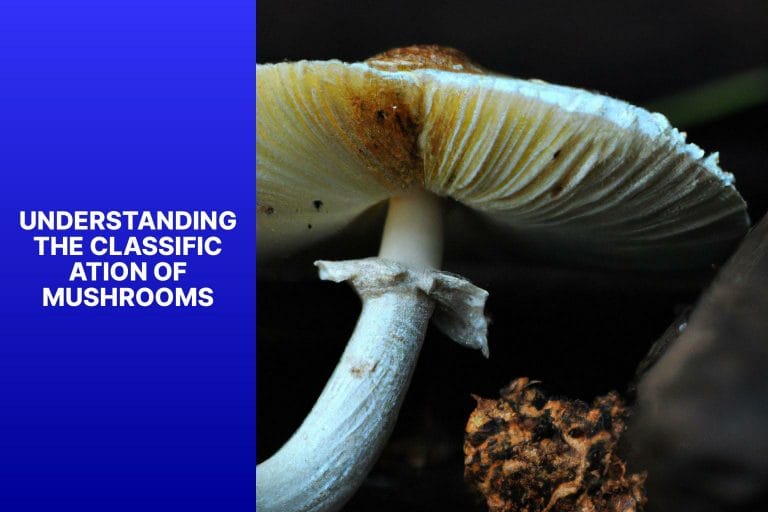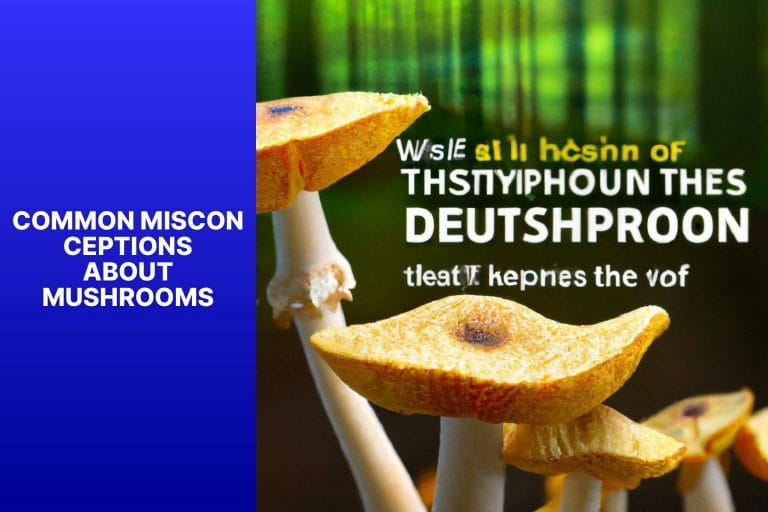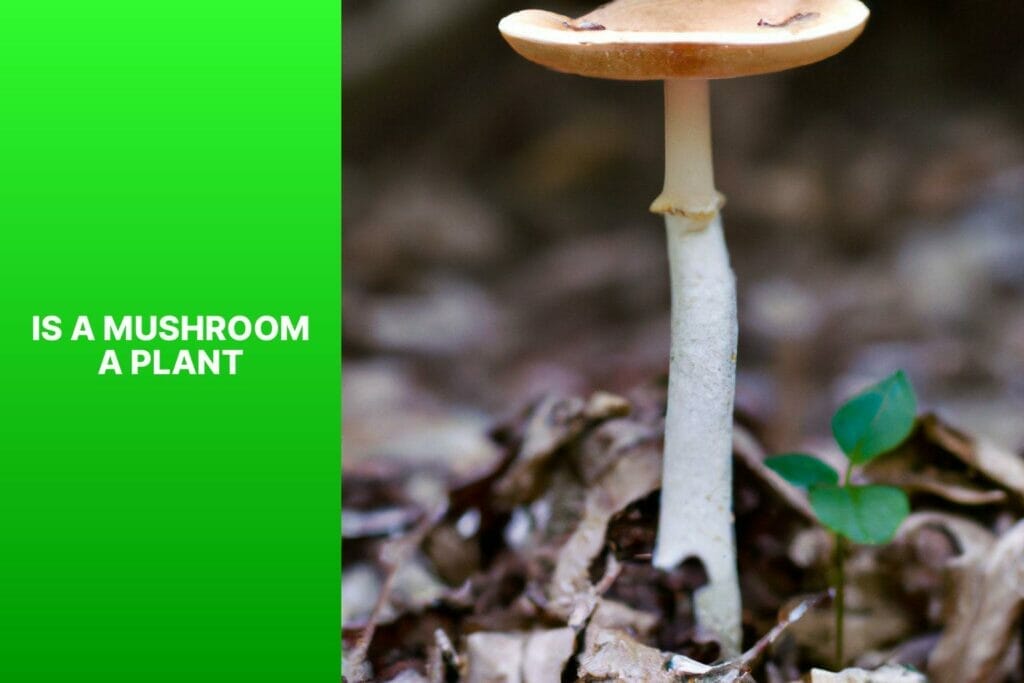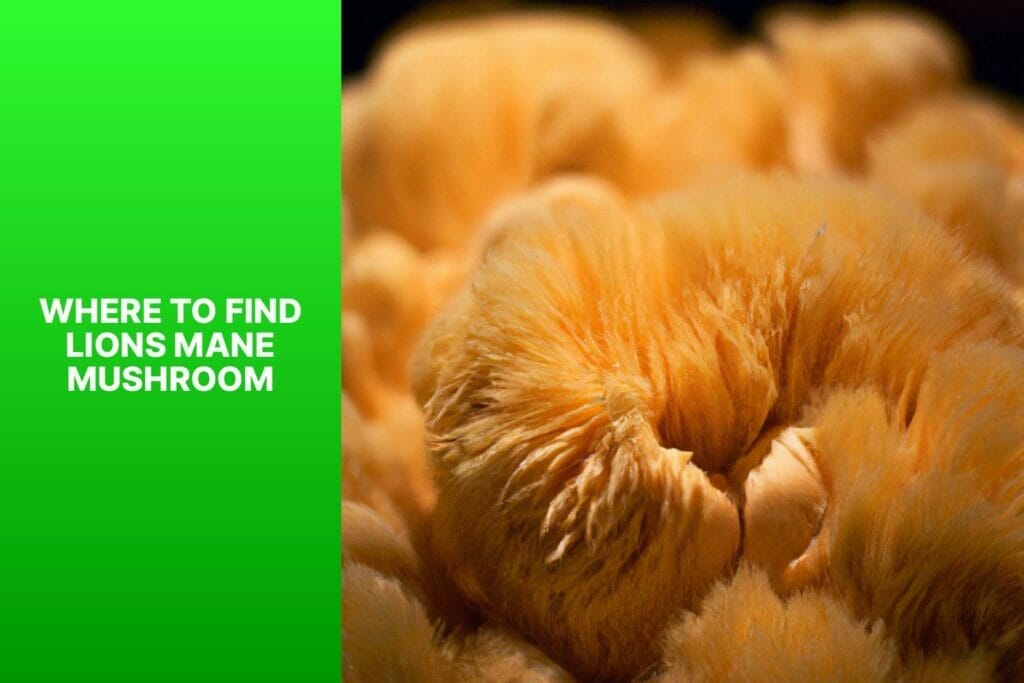Mushrooms have long fascinated people with their unique appearance and properties. There is often confusion about whether mushrooms are classified as plants.
In this article, we will explore the classification of mushrooms and shed light on their distinct characteristics.
Understanding the differentiation between mushrooms and plants is crucial to gain a deeper insight into the fascinating world of fungi.
The topic at hand is: Is a Mushroom a Plant? We will delve into the various aspects of mushrooms to provide a comprehensive understanding of their classification.
To begin, let’s explore what exactly mushrooms are and the key characteristics that define them.
Mushrooms are fungal organisms belonging to the fungi kingdom. They are neither classified as plants nor animals. Mushrooms display distinct features that differentiate them from plants, including their cellular structure, mode of nutrition, and reproductive mechanisms.
We will compare these aspects between mushrooms and plants to highlight their contrasting attributes.
We will discuss the classification of mushrooms within the fungi kingdom and explore the different types of mushrooms. Understanding the diversity within the mushroom family will give us a broader perspective on their significance in various ecosystems.
We will uncover the importance of mushrooms, both ecologically and in human life. Mushrooms play a vital ecological role in nutrient cycling and symbiotic relationships.
They have also been valued for centuries for their culinary and medicinal uses, making them an integral part of many cultures across the globe.
We will address misconceptions about mushrooms, such as their categorization as vegetables or fruits. By dispelling these misconceptions, we can better understand the unique nature of mushrooms and their place in the natural world.
Join us as we explore the intriguing world of mushrooms and unravel the mysteries surrounding their classification and significance.
Key takeaway:
- Mushrooms are not plants: Despite some similarities, mushrooms are classified as fungi, not plants. They have distinct cellular structures and modes of nutrition, differentiating them from plants.
- Mushrooms serve important ecological roles: Mushrooms play a vital role in ecosystems as decomposers, aiding in the breakdown of organic matter and nutrient recycling. They contribute to maintaining a balanced ecosystem.
- Mushrooms have diverse uses: Besides their culinary uses, mushrooms have long been used in traditional medicine for their medicinal properties. They contain compounds with potential health benefits, making them valuable in medical research.
Is a Mushroom a Plant?
A mushroom is a type of fungus, not a plant. Therefore, the answer to the question “Is a mushroom a plant?” is no. Unlike plants, mushrooms lack chlorophyll and cannot perform photosynthesis. Instead, they obtain nutrients by breaking down organic matter.
Mushrooms reproduce through spores instead of seeds. They have a unique structure called mycelium, a network of thread-like filaments. Mushrooms belong to the fungi kingdom, while plants belong to the plant kingdom.
While plants and mushrooms are living organisms, they have distinct characteristics that set them apart.
Understanding the Classification of Mushrooms

Photo Credits: True2Mushrooms.Com by Raymond Thomas
Understanding the Classification of Mushrooms
| Classification | Characteristics |
| Kingdom | Fungi |
| Phylum | Basidiomycota or Ascomycota |
| Class | Agaricomycetes or Pezizomycetes |
| Order | Agaricales, Boletales, or Russulales |
| Family | Amanitaceae, Tricholomataceae, or Strophariaceae |
| Genus | Amanita, Psilocybe, or Agaricus |
| Species | Amanita muscaria, Psilocybe cubensis, or Agaricus bisporus |
Understanding the classification of mushrooms is crucial in recognizing their place in the natural world. Mushrooms belong to the kingdom of Fungi, separate from plants. They are categorized into phyla, classes, orders, families, genera, and species.
For example, the class can be Agaricomycetes or Pezizomycetes, and the order can vary, such as Agaricales, Boletales, or Russulales.
By understanding the classification, we can identify the unique characteristics of different mushrooms. For instance, the Amanitaceae family includes the well-known Amanita muscaria, while the Psilocybe genus encompasses species like Psilocybe cubensis.
Each classification level provides specific information about the mushroom’s traits, habitat, and behavior.
Fact: Over 14,000 mushroom species have been identified and classified. Scientists estimate that there may be up to 140,000 additional undiscovered species.
What Are Mushrooms?
Mushrooms are not plants, but they belong to the Fungi kingdom. They are unique organisms with distinct characteristics.
Mushrooms are fungal fruiting bodies, which are the reproductive structures produced by fungi. These organisms play a vital role in ecosystems and have various culinary and medicinal uses.
Key Characteristics of Mushrooms:
- Cellular Structure and Composition: Mushrooms have cell walls made of chitin, a tough and flexible material. Unlike plants, they do not contain chlorophyll and cannot perform photosynthesis.
- Mode of Nutrition: Mushrooms are heterotrophs and obtain nutrients by decomposing organic matter or forming mutualistic relationships with other organisms. They absorb nutrients through their mycelium, a network of thread-like structures.
- Reproduction and Life Cycle: Mushrooms reproduce by releasing spores like seeds. These spores germinate and develop into mycelium, eventually forming a mushroom under favorable conditions.
Types of Mushrooms:
Mushrooms come in various shapes, sizes, and colors. Common types include button mushrooms, shiitake, oyster, and portobello mushrooms.
Importance of Mushrooms:
Mushrooms have an ecological role in breaking down dead plant material and recycling ecosystem nutrients. They are also valued for their culinary uses, adding unique flavors and textures to dishes.
Key Characteristics of Mushrooms
Here is a table highlighting the key characteristics of mushrooms:
| Characteristics | Description |
| Structure | Mushrooms have a stem and a cap. The cap is often domed or umbrella-shaped. |
| Size | Sizes of mushrooms can vary greatly, ranging from millimeters to meters in diameter. |
| Color | Mushrooms come in various colors, including white, brown, yellow, and black. Some species display vibrant colors. |
| Gills | The underside of the mushroom cap contains gills, which produce and release spores for reproduction. |
| Veil | Many mushrooms have a veil, a thin membrane that covers the gills when the mushroom is young. |
| Scent | Mushrooms can have distinct scents that vary depending on the species. |
| Taste | The taste of mushrooms can range from mild and earthy to meaty and savory. |
| Spores | Mushrooms produce microscopic spores as part of their reproductive process, which is vital in mushroom dispersal. |
| Edibility | While some mushrooms are edible, others are toxic or deadly. Proper identification is crucial. |
Comparison Between Mushrooms and Plants
Regarding mushrooms and plants, fascinating differences go beyond their appearance. This section explores the intriguing nuances between these two organisms.
From their cellular structure and composition to their mode of nutrition and even their reproduction and life cycle, we’ll uncover the distinctive characteristics that set mushrooms apart from plants. Get ready for a captivating journey into nature’s diverse creations.
Cellular Structure and Composition
The cellular structure and composition of mushrooms differ significantly from that of plants. Unlike plants, mushrooms have chitin as their main component, typically found in insects’ exoskeletons. Chitin makes up the cell walls of mushrooms, providing them with strength and protection.
On the other hand, plant cell walls are composed of cellulose.
Mushrooms belong to the fungi kingdom and are eukaryotic organisms with a nucleus and other organelles. Similarly, plant cells are also eukaryotic but have additional structures, such as chloroplasts, essential for photosynthesis.
Regarding composition, mushrooms have mycelium, which is comprised of hyphae. These hyphae extend through organic matter and create a network known as a mycelial network.
In contrast, plant cells contain chloroplasts and specialized structures like xylem and phloem, which facilitate the transportation of water and nutrients.
A thorough understanding of mushrooms’ cellular structure and composition is crucial in distinguishing them from plants. Plants rely on cellulose-based cell walls and possess unique structures required for photosynthesis.
On the other hand, mushrooms rely on chitin-based cell walls and depend on mycelium for nutrient absorption. These distinct characteristics highlight the classification of mushrooms as fungi rather than plants.
Mode of Nutrition
Mushrooms exhibit two distinct modes of nutrition: saprotrophic and parasitic. Saprotrophic mushrooms sustain themselves by extracting nutrients from decomposing dead organisms, thereby contributing to the decomposition of organic matter and nutrient recycling within the ecosystem.
Prominent examples of saprotrophic mushrooms include the Agaricus bisporus, the button mushroom, the Pleurotus ostreatus, and the oyster mushroom. On the other hand, parasitic mushrooms acquire their nourishment by infecting living organisms, often resulting in harm or demise for their hosts.
Notable parasitic mushrooms include the Armillaria spp., more commonly referred to as the honey fungus, and the Cordyceps spp., which target insects as a medium for growth.
It is essential to acknowledge that mushrooms differ from plants in their inability to undergo photosynthesis due to the absence of chlorophyll. Instead, they rely on external sources, such as organic matter or living organisms, to procure nutrients for their growth and development.
Reproduction and Life Cycle
| Reproduction | Life Cycle |
| Mushrooms reproduce through their life cycle. | The life cycle of a mushroom begins when it releases spores from the gills or pores on its cap. |
| Spores, reproductive cells, can be dispersed by wind, water, or animals. | If the conditions are favorable, the spores germinate and form hyphae, thread-like structures. |
| The hyphae grow and merge, forming the mycelium, the vegetative body of the mushroom. | The mycelium continues to grow, extracting nutrients from its environment. |
| Under suitable conditions, the mycelium develops fruiting bodies, which are the mushrooms. | The fruiting bodies contain the reproductive structures of the mushroom, including cells that produce spores. |
| When the fruiting bodies mature, they release spores to initiate a new life cycle. | The dispersed spores can land in new environments where they can germinate and create new mycelium. |
Classification of Mushrooms
Classifying mushrooms requires a deep dive into the intriguing world of fungi. In this exploration, we’ll uncover the diverse realms of the fungal kingdom and embark on a journey through the various types of mushrooms.
Prepare to be captivated by the fascinating facts and remarkable characteristics that define these enigmatic organisms. From their vital ecological roles to their culinary and medicinal significance, we’ll unravel the mysteries of mushrooms and shed light on their undeniable distinction within the natural world.
Fungi Kingdom
The Fungi Kingdom is a unique classification within organisms. It is important to understand its characteristics and role in nature.
| Kingdom Name | Fungi |
| Organism Type | Eukaryotic |
| Cellular Structure | Multicellular or unicellular |
| Mode of Nutrition | Heterotrophic |
| Reproduction | By spores |
| Life Cycle | Varies between species |
The Fungi Kingdom includes mushrooms, molds, and yeasts. They break down organic matter and aid in nutrient cycling. Fungi also have culinary and medicinal uses.
Edible mushrooms like chanterelles and portobello are prized for cooking. Medicinal mushrooms like Reishi and lion’s mane are believed to have health benefits.
Fungi differ from plants in cellular structure, mode of nutrition, and reproduction. While plants use photosynthesis to produce food, fungi obtain nutrients by breaking down organic matter. Fungi also have chitin in their cell walls instead of cellulose found in plants.
Understanding the Fungi Kingdom is crucial for appreciating the diversity and importance of these organisms in our ecosystem. By recognizing their unique characteristics, we can better appreciate their role in nature and harness their culinary and medicinal benefits.
Types of Mushrooms
There are different types of mushrooms in nature, each with unique characteristics and uses. Here is a table that highlights popular mushrooms:
| Mushroom | Scientific Name | Edibility |
|---|---|---|
| Button Mushroom | Agaricus bisporus | Edible |
| Shiitake | Lentinula edodes | Edible |
| Portobello | Agaricus bisporus | Edible |
| Morel | Morchella spp. | Edible |
| Chanterelle | Cantharellus spp. | Edible |
| Porcini | Boletus edulis | Edible |
| Oyster | Pleurotus ostreatus | Edible |
| Enoki | Flammulina velutipes | Edible |
| Lion’s Mane | Hericium erinaceus | Edible |
| Reishi | Ganoderma lucidum | Medicinal |
Each mushroom has a unique taste, texture, and nutritional profile. Some mushrooms are commonly used in cooking, adding flavor and depth to various cuisines. Other mushrooms, like Reishi, have traditionally been used in traditional medicine for potential health benefits.
A true story:
One day, while hiking through the forest, I found a grove of beautiful Chanterelle mushrooms. These vibrant and fragrant mushrooms were amazing. Excitedly, I harvested a few and took them home to prepare a delicious meal.
Their earthy flavor and delicate texture elevated the dish, delighting everyone who tasted it. Since then, my love for mushrooms has only grown, and I continue to explore the wonderful world of these fascinating fungi.
Importance of Mushrooms
Mushrooms are not just your average fungi – they play a significant role in our environment and have many uses. This section will explore mushrooms’ importance, ecological role, and various culinary and medicinal uses.
Brace yourself for fascinating insights and discover why mushrooms hold a special place in nature and human endeavors.
Ecological Role
Mushrooms play a crucial ecological role in ecosystems, serving as important decomposers of dead plants and animals. As they break down organic matter, they release essential nutrients into the soil, making them available for other organisms.
Mushrooms establish symbiotic relationships with tree and plant roots, known as mycorrhizae, enabling plants to obtain vital nutrients and enhancing their ability to withstand diseases and environmental stressors. These mutually beneficial interactions between mushrooms and other organisms highlight the interconnectedness of life within ecosystems.
Please visit the National Park Service for more information on whether a mushroom is a plant.
Mushrooms contribute to the overall biodiversity by creating habitats for various organisms. Many species, including insects, rodents, and larger animals, depend on mushrooms for nourishment and shelter.
Certain types of mushrooms can serve as indicators of ecosystem health, reflecting the environmental conditions in a given area.
Some species are sensitive to pollution, while others thrive in undisturbed forests, making them useful markers of environmental quality.
Recognizing the ecological role of mushrooms is fundamental for conservation efforts and preserving healthy ecosystems. Safeguarding mushroom populations and their habitats ensures ecosystems’ continued functioning and biodiversity preservation.
By valuing and understanding mushrooms’ vital role, we can deepen our comprehension of nature’s intricate and interconnected web of life.
Culinary and Medicinal Uses
| Culinary Uses | Medicinal Uses |
| Mushrooms are widely appreciated in many cuisines around the world. | Mushrooms have been utilized for their medicinal properties for centuries. |
| They contribute flavors, textures, and nutritional value to various dishes. | Mushrooms offer various health benefits and have been used medicinally. |
| Many culinary professionals highly value mushrooms for their umami taste. | Some mushrooms possess antimicrobial properties and can be used medicinally. |
| Mushrooms can be cooked or enjoyed raw in salads and sandwiches. | Certain medicinal mushrooms have the potential to enhance the immune system. |
| They are versatile and can be incorporated into soups, stir-fries, pasta dishes, and more. | Some mushrooms demonstrate potential anti-inflammatory effects and can be used medicinally. |
True story:
I had the opportunity to visit a quaint Asian village where mushrooms played a significant role in the local cuisine. The villagers would venture into the forests to forage for mushrooms and then use them in traditional dishes.
They firmly believed that mushrooms enhanced their meals’ flavors and improved their overall well-being. I was captivated by the vibrant colors and unique textures of the mushrooms they incorporated.
The villagers graciously shared their knowledge about different varieties of mushrooms and their various medicinal applications. It was a truly fascinating experience to witness the cultural reverence for mushrooms and gain a deeper understanding of their significance in culinary and medicinal practices.
This eye-opening encounter broadened my culinary horizons and deepened my appreciation for the versatile uses of mushrooms across different cultures.
Common Misconceptions about Mushrooms

Photo Credits: True2Mushrooms.Com by Ethan Baker
Common misconceptions about mushrooms, such as the belief that they are plants or vegetables, often arise from misunderstandings or lack of information. It is important to debunk these common misconceptions to understand mushrooms better. Here are some key points to consider:
1. Mushrooms are not plants: It is crucial to understand that mushrooms belong to the fungi classification, which separates them from plants, animals, and bacteria.
2. Not all mushrooms are edible: While mushrooms can be enjoyed as a delicious culinary ingredient, it is vital to note that some varieties can be poisonous and lead to severe illness or even death if ingested. Therefore, it is essential to have proper knowledge or seek expert advice before consuming wild mushrooms.
3. Mushrooms are not vegetables: Despite their culinary uses and vegetable-like appearance, mushrooms belong to the fungi kingdom and possess distinct characteristics that set them apart from true vegetables.
4. Mushrooms have various uses: Besides being used in cooking, mushrooms also have medicinal applications. Medicinal mushrooms like Reishi and Chaga have been utilized in traditional medicine for centuries. Mushrooms play a crucial role in ecosystems by decomposing organic matter and assisting in nutrient cycling.
Mushrooms have a rich and captivating history, having been consumed as food and used in traditional medicine by various cultures for thousands of years. Ancient civilizations in Egypt, China, and Greece recognized their potential benefits and incorporated them into their practices.
In addition, mushrooms have held symbolic and spiritual significance and have been employed in religious ceremonies and rituals. Ongoing research continues to unveil mushrooms’ medicinal properties and potential therapeutic uses.
To fully appreciate mushrooms’ unique qualities and contributions to our world, it is essential to distinguish fact from fiction and dispel common misconceptions.
Some Facts About Whether a Mushroom is a Plant:
- ✅ Mushrooms are not plants but types of fungi. They have a stem and cap and belong to their kingdom of life. (Source: Our Team)
- ✅ The majority fungi, including mushrooms, are underground and can be acres in size. Mushrooms are the reproductive structure produced by some fungi, similar to the fruit of a plant. (Source: Our Team)
- ✅ Mushrooms do not make their food as plants do through photosynthesis. Fungi obtain their nutrients differently from plants and animals. (Source: Our Team)
- ✅ Fungi, including mushrooms, are important in recycling nutrients and breaking down dead plant materials. They help in the decomposition and maintain ecosystemic health. (Source: Our Team)
- ✅ Molecular evidence supports the separation of fungi, including mushrooms, from plants. Fungi are more closely related to animals than plants. (Source: Our Team)


